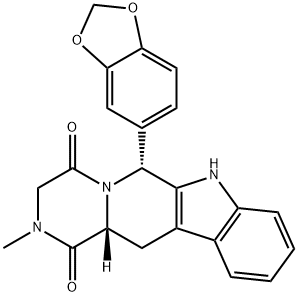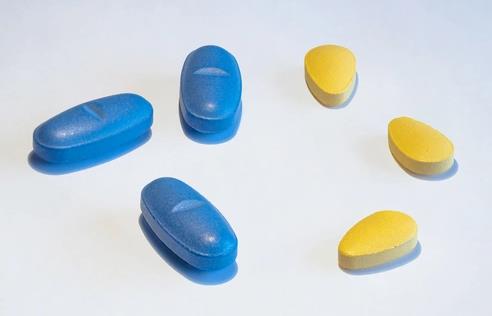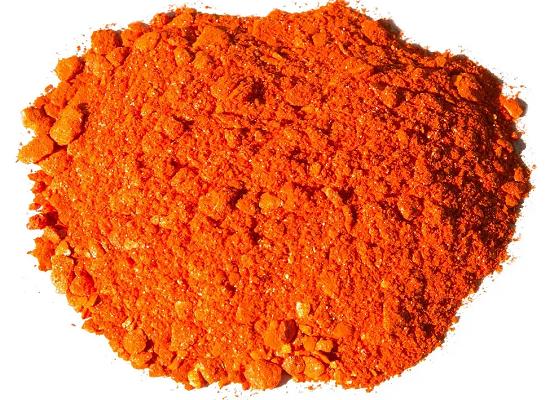Tadalafil: Mechanism of Action and Pharmacokinetics
General Description
Tadalafil, a potent phosphodiesterase type 5 inhibitor, functions by preventing the breakdown of cGMP, leading to smooth muscle relaxation and improved blood flow for erectile dysfunction treatment. Its mechanism involves binding to PDE5, inhibiting its catalytic activity selectively and efficiently. Tadalafil's pharmacokinetic profile, characterized by a long half-life of 17.5 hours and minimal food effects, supports its extended 36-hour duration of action and convenient dosing. Tadalafil's high selectivity for PDE5 over other phosphodiesterases reduces potential side effects and visual disturbances, making it a preferred choice with predictable absorption and metabolic pathway considerations for patients.

Figure 1. Tadalafil
Mechanism of Action
Tadalafil, a potent pharmaceutical agent, primarily works by inhibiting the enzyme phosphodiesterase type 5 (PDE5), which is crucial in the regulation of cGMP in smooth muscle cells. The mechanism of Tadalafil centers around its ability to prevent the breakdown of cGMP, a molecule that influences the relaxation of smooth muscle tissue. The specific action of Tadalafil involves blocking the binding of cGMP to the catalytic domain of PDE5. By doing this, Tadalafil makes it impossible for PDE5 to catalyze the conversion of cGMP into the inactive 5ʹ-GMP. This process is critical because cGMP plays a pivotal role in controlling blood flow and vasodilation in the corpus cavernosum, thereby facilitating erections in males. Tadalafil achieves its inhibitory effect through a series of molecular interactions. It forms hydrogen bonds with the indole ring and the side chain of the glutamine residue at position 817 in PDE5. This precise bonding helps stabilize Tadalafil within the catalytic pocket of the enzyme, effectively blocking its activity. Furthermore, Tadalafil's methylenedioxyphenyl group, which allows for greater conformational mobility, also contributes to its high affinity for PDE5. This particular group interacts with additional residues in subdomains of the enzyme, enhancing the drug's selectivity and efficacy. The high specificity of Tadalafil for PDE5 compared to other phosphodiesterases like PDE6 or PDE9, which are involved in other cellular processes, is noteworthy. This selectivity is important because it minimizes potential side effects related to the inhibition of other PDE enzymes. Consequently, Tadalafil's targeted mechanism not only ensures efficient smooth muscle relaxation and increased blood flow but also maintains a favorable safety profile, making it an effective treatment for conditions like erectile dysfunction. 1
Pharmacokinetics
Tadalafil is a selective phosphodiesterase type 5 inhibitor, widely used for treating erectile dysfunction and benign prostatic hyperplasia. Its pharmacokinetic properties provide a significant advantage over other PDE5 inhibitors like sildenafil and vardenafil. One of the most notable pharmacokinetic attributes of tadalafil is its long half-life of approximately 17.5 hours, which contributes to an extended duration of action of up to 36 hours. This contrasts sharply with sildenafil and vardenafil, which have much shorter half-lives and durations of action. The absorption of tadalafil is not significantly affected by food intake, which simplifies its administration compared to other medications that must consider dietary influences on drug absorption. This feature, along with its dose linearity, where the effects of the drug are proportional to the dosage, makes tadalafil a convenient and predictable choice for patients. Tadalafil's selectivity for PDE5 is also notable when compared to its effects on other phosphodiesterase enzymes. While all PDE5 inhibitors can potentially inhibit PDE6—an enzyme found in the retina and involved in phototransduction—tadalafil does so with less frequency and intensity, resulting in fewer visual disturbances like blurred vision or light sensitivity. This characteristic is due to tadalafil's higher PDE5/PDE6 selectivity ratio compared to sildenafil and vardenafil. Moreover, tadalafil's metabolic process primarily involves the cytochrome P450 (CYP) 3A4 enzyme. This is crucial for its biotransformation and affects its interaction with other medications metabolized by the same pathway, necessitating consideration of potential drug-drug interactions. In summary, the pharmacokinetics of tadalafil supports its clinical use for sustained periods due to its long half-life, stable and predictable absorption regardless of food intake, and a high degree of selectivity for PDE5 over other isoenzymes like PDE6 and PDE11. These pharmacokinetic advantages make tadalafil a reliable and preferred choice in its therapeutic class. 2
Reference
1. Huang YY, Li Z, Cai YH, et al. The molecular basis for the selectivity of tadalafil toward phosphodiesterase 5 and 6: a modeling study. J Chem Inf Model. 2013; 53: 3044-3053.
2. Mónica FZ, De Nucci G. Tadalafil for the treatment of benign prostatic hyperplasia. Expert Opin Pharmacother. 2019; 20(8): 929-937.
Related articles And Qustion
Lastest Price from Tadalafil manufacturers

US $10.00/box2025-12-02
- CAS:
- 171596-29-5
- Min. Order:
- 1box
- Purity:
- 99%
- Supply Ability:
- 1000Kilogram/Month

US $10.00/box2025-12-02
- CAS:
- 171596-29-5
- Min. Order:
- 1box
- Purity:
- 99%
- Supply Ability:
- 1000Kilogram/Month




